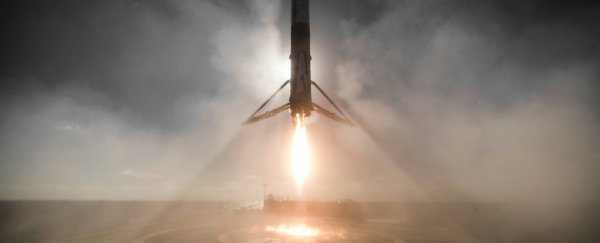Space X has been steadily nailing landings on a floating platform at sea for months now.
But over the weekend, the innovative space company accomplished something even more impressive - it flew one of its reusable Falcon 9 rockets back to Cape Canaveral Air Force Station in Florida, and achieved a smooth touch-down on the tarmac for only the third time on land.
You can see that beautiful landing in the footage below. It's so perfect, it hardly looks real:
Here's a more detailed look at that landing again, because we can't get enough:

Impressive return flights aside, the launch itself is pretty historic - Falcon 9 took off on Sunday from Launch Complex 39A at Kennedy Space Centre in Florida - the same launch pad that was used for the Apollo missions in the '60s.
It was at launch complex 39A that Apollo 11 blasted off from before shuttling humans to the Moon for the very first time back in 1969. And this weekend was the first time that any spacecraft had launched from that pad since NASA's Space Shuttle Atlantis took its final flight in July, 2011.
It's also SpaceX's first launch from Florida since their devastating explosion in September last year.
The Falcon 9 rocket that launched on the weekend was carrying a Dragon supply ship to the International Space Station as part of a resupply mission for NASA. It was filled with around 2,500 kg (5,500 pounds) of cargo and science experiments - including a lethal superbug that could teach us about the future of disease here on Earth.
About 10 minutes after launch, the first stage of the rocket - the part that gives it enough power to get off the ground - had flown back to land, touching down at SpaceX's Landing Zone 1 pad at Cape Canaveral Air Force.
It's only the third time SpaceX has landed a rocket on land, but it's the eighth successful landing overall of a reusable Falcon 9 rocket.
The reusable rocket is key to Musk's ultimate plan of reducing the cost of launching people and objects into space.
In a traditional launch, the rocket's first stage is left to crash into the ocean after it's done its job. But by recovering the Falcon 9 rockets, SpaceX saves the estimated US$62 million cost of building a new one each time it wants to launch something into space.
As humans move further and further away from our home planet, that's going to be a very big deal. Space X expects to launch one of these recovered rockets as early as October to test whether they work as well the second time around.
"Baby came back," Elon Musk posted on Instagram shortly after the successful landing.
"It was really awesome to see 39A roar back to life," SpaceX Dragon program manager Jessica Jensen told reporters after the launch. "This is a huge deal for us."
A few minutes after the Falcon 9 rocket touched down again, the Dragon supply ship successfully entered Earth's orbit. It's expected to dock with the International Space Station on Wednesday.
You can see the full hosted webcast of the launch below (skip to around the 19:50 mark when the rocket launches):

The launch was first scheduled for 14 February, but was moved to Saturday due to weather concerns. Saturday's launch was also scrubbed in the final seconds due to steering concerns in the rocket's upper state.
But the updated launch on Sunday went off without a hitch.
According to the Associated Press, NASA was watching the launch closely before it clears SpaceX to carry NASA astronauts.
